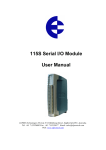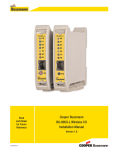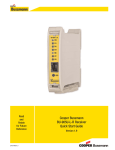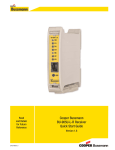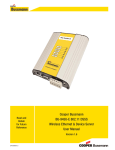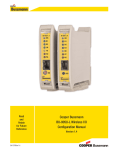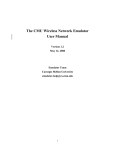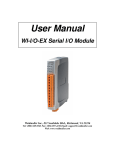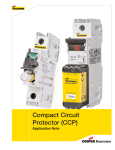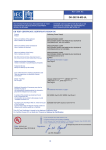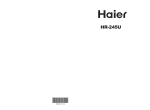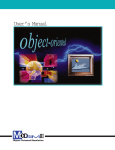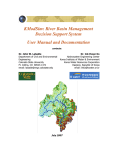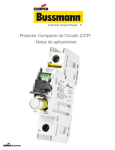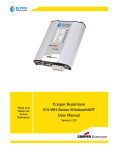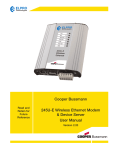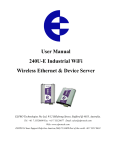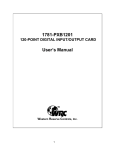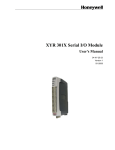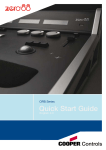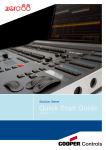Download Cooper Bussmann BU-115S Serial I/O Module User Manual
Transcript
Read and Retain for Future Reference Cooper Bussmann BU-115S Serial I/O Module User Manual Version 1.14 3A1574Rev1.14 Cooper Bussmann BU-115S Serial I/O Module User Manual Cooper Bussmann Application Engineering • Phone 8:00 a.m - 5:00 p.m. Central, M-F (636) 527-1270 • Fax: (636) 527-1607 • E-mail: [email protected] Thank you for your selection of the BU-115S Serial I/O Module. We trust it will give you many years of valuable service. ATTENTION! Incorrect termination of supply wires may cause internal damage and will void warranty. To ensure your BU-115S product enjoys a long life, Double check ALL your connections with the User Manual, before turning the power on. All equipment must be properly grounded for safe operation. All equipment should be serviced only by a qualified technician. Important Notice Cooper Bussmann products are designed to be used in industrial environments, by experienced industrial engineering personnel with adequate knowledge of safety design considerations. These products should not be used in non-industrial applications, or life-support systems, without consulting Cooper Bussmann first. Installation and Operating Instructions: The Expansion I/O modules are to be installed by trained personnel / licensed electricians only and installation must be carried out in accordance with the instructions listed in the Installation Guide and applicable local regulatory codes. The units are intended for Restricted Access Locations. The Expansion I/O modules are intended to be installed in a final enclosure, rated IP54, before use outdoors. The Equipment shall be powered using an external Listed Power Supply with LPS outputs or a Class 2 Power Supply. Hazardous Location Notices: This device complies with: • Ex nL IIC. T6 -40 C <= Ta <= +60 C • WARNING: EXPLOSION HAZARD. • Do not disconnect equipment unless power has been switched off or the area is known to be non-hazardous. 2 www.cooperbussmann.com/BussmannWirelessResources 3A1574Rev1.14 Cooper Bussmann BU-115S Serial I/O Module User Manual CONTENTS 1 OVERVIEW . . . . . . . . . . . . . . . . . . . . . . . . . . . . . . . . . . . . . . .4 1.1 Module Type and Features . . . . . . . . . . . . . . . . . . . . . . . . .5 1.1.1 Digital inputs / outputs . . . . . . . . . . . . . . . . . . . . . . . .5 1.1.2 Pulsed outputs . . . . . . . . . . . . . . . . . . . . . . . . . . . . . .5 1.1.3 Pulsed inputs . . . . . . . . . . . . . . . . . . . . . . . . . . . . . . .6 1.1.4 Analog inputs . . . . . . . . . . . . . . . . . . . . . . . . . . . . . . .6 1.1.5 Analog outputs . . . . . . . . . . . . . . . . . . . . . . . . . . . . . .6 1.1.6 Communications . . . . . . . . . . . . . . . . . . . . . . . . . . . . .7 2 INSTALLATION . . . . . . . . . . . . . . . . . . . . . . . . . . . . . . . . . . . .8 2.1 General Installation . . . . . . . . . . . . . . . . . . . . . . . . . . . . . .8 2.1.1 Power Connection . . . . . . . . . . . . . . . . . . . . . . . . . . .8 2.1.2 Address Switches . . . . . . . . . . . . . . . . . . . . . . . . . . . .9 2.2 Signal Connections . . . . . . . . . . . . . . . . . . . . . . . . . . . . .10 2.2.1 Digital Inputs (and Pulsed Inputs) . . . . . . . . . . . . . . . .10 2.2.2 Digital Outputs (and Pulsed Outputs) . . . . . . . . . . . . .10 2.2.3 Analog Inputs . . . . . . . . . . . . . . . . . . . . . . . . . . . . . .11 2.2.4 Analog Outputs . . . . . . . . . . . . . . . . . . . . . . . . . . . . .15 5 OPERATION . . . . . . . . . . . . . . . . . . . . . . . . . . . . . . . . . . . . . .31 5.1 BU-115S-11 Module . . . . . . . . . . . . . . . . . . . . . . . . . . . .31 5.2 BU-115S-12 Module . . . . . . . . . . . . . . . . . . . . . . . . . . . .32 5.3 BU-115S-13 Module . . . . . . . . . . . . . . . . . . . . . . . . . . . .33 5.4 Hexadecimal Representation of Voltage and Current Levels 34 APPENDIX A. MODBUS ADDRESS MAP . . . . . . . . . . . . . . . . . .35 A.1. BU-115S-11 . . . . . . . . . . . . . . . . . . . . . . . . . . . . . . . . .35 A.2. BU-115S-12 . . . . . . . . . . . . . . . . . . . . . . . . . . . . . . . . .36 A.3. BU-115S-13 . . . . . . . . . . . . . . . . . . . . . . . . . . . . . . . . .37 APPENDIX B. MODBUS FUNCTIONALITY . . . . . . . . . . . . . . . . .38 APPENDIX C. COMMS RECOVERY . . . . . . . . . . . . . . . . . . . . . .39 APPENDIX D. SPECIFICATIONS . . . . . . . . . . . . . . . . . . . . . . . .41 APPENDIX E. RS232 WIRING . . . . . . . . . . . . . . . . . . . . . . . . . .43 3 CONFIGURATION . . . . . . . . . . . . . . . . . . . . . . . . . . . . . . . . . .17 3.1 MODBUS Slave Configuration . . . . . . . . . . . . . . . . . . . . . .17 4 HARDWARE CONFIGURATION . . . . . . . . . . . . . . . . . . . . . . . .18 4.1 Connecting to the BU-115S Module . . . . . . . . . . . . . . . . .18 4.2 Configuration Common to All Modules . . . . . . . . . . . . . . .19 4.2.1 Communications . . . . . . . . . . . . . . . . . . . . . . . . . . . .19 4.2.2 Modbus Output Timeout on Comms fail . . . . . . . . . . .19 4.2.3 Configurable ACK Timeout . . . . . . . . . . . . . . . . . . . . .20 4.2.4 Pulsed outputs . . . . . . . . . . . . . . . . . . . . . . . . . . . . .21 4.3 BU-115S-11 Configuration . . . . . . . . . . . . . . . . . . . . . . .22 4.3.1 Pulsed Inputs . . . . . . . . . . . . . . . . . . . . . . . . . . . . . .22 4.4 BU-115S-12 Configuration . . . . . . . . . . . . . . . . . . . . . . .22 4.4.1 Voltage input . . . . . . . . . . . . . . . . . . . . . . . . . . . . . .22 4.4.2 Current input . . . . . . . . . . . . . . . . . . . . . . . . . . . . . .25 4.5 BU-115S-13 Configuration . . . . . . . . . . . . . . . . . . . . . . .27 4.5.1 Voltage output . . . . . . . . . . . . . . . . . . . . . . . . . . . . .27 4.5.2 Current output . . . . . . . . . . . . . . . . . . . . . . . . . . . . .29 3A1574Rev1.14 www.cooperbussmann.com/BussmannWirelessResources 3 Cooper Bussmann BU-115S Serial I/O Module 1. OVERVIEW The Cooper Bussmann BU-115S modules are designed to provide I/O expansion for other Cooper Bussmann products like BU-245U-E and BU-945U-E modules. The BU-115S modules support the standard Modbus protocol and communicate serially via RS232 or RS485. Configuration is done via the Cooper Bussmann BU-115S configuration utility. The BU-115S modules support MODBUS protocol and can be used as a MODBUS slave with any 3rd-party MODBUS device. They support both MODBUS ASCII protocol, and serial un-signed MODBUS RTU, also known as “MODBUS binary.” The Modbus slave address of the BU-115S is selected via two rotary switches on the bottom panel of the case. All BU-115S models provide digital inputs and outputs. Specific models provide analog inputs or analog outputs. Pulsed inputs and pulsed outputs are also available. Several modules may be connected to one master, allowing any combination of I/O types. Figure 1 1 shows a diagram of a BU-115S module with parts labeled. RS485 Terminal Switch RS485 and Power Connector RS232 Configuration Connector Address Switches Status LEDs I/O Connector Power DIN Rail Mount OK Transmit Receive Analog Configuration Access Panel Figure 1 1: BU-115S unit with significant parts labeled. Two ports allow configuration and communications on the BU-115S. The RS232 port is intended for configuration. The RS485 port allows the unit to be in a multi-drop configuration. Overvoltage protection and supply monitoring is provided to minimize the risk of failure due to faulty connections or supply surges. 4 www.cooperbussmann.com/BussmannWirelessResources 3A1574Rev1.14 Cooper Bussmann BU-115S Serial I/O Module 1.1 Module Types and Features The module types and I/O are summarized in Table 1 1. BU-115S -11 -12 -13 Digital inputs/outputs 16 8 8 Pulse outputs 8 8 8 Pulse inputs 4 - - Analog inputs - 8 - Analog outputs - - 8 Table 1 1: Summary of BU-115S module types and I/O. 1.1.1 Digital Inputs / Outputs Each digital I/O channel on the BU-115S modules can act as either an input or an output. The input/output direction does not need to be user configured. Digital inputs are suitable for voltage-free contacts, or NPN-transistor switch devices. Digital outputs are open-collector transistor outputs, able to switch loads up to 30Vdc, 200mA. If you have wired an input/output channel as an input, it is recommended that you do not write values to it as an output. No electrical damage will occur if you attempt to use a channel wired as an input as an output, or vice-versa, however the I/O system will not operate correctly. We recommend that the required digital inputs be assigned consecutively from channel 1. Then use the remaining channels as digital outputs. 1.1.2 Pulsed Outputs The first eight digital channels on each BU-115S module can be used as pulse outputs. The maximum output frequency is 50Hz. A pulse output on the BU-115S will output the number of pulses equal to the register value sent by the master. When the master sends a new register value, the BU-115S will output additional pulses until the output count is the same as the new value. Three register values are associated with creating each pulsed output: • The Count keeps a tally of how many pulses have been output - this is a 16-bit register and overflows to 0. • The Target is set by the master, and is the trigger for pulses to be created. The digital channel outputs pulses until the Count value reaches the Target value. If the Target register is set to 0, the pulses stop and the Count register is cleared. • The Update Time is the interval in which the BU-115S expects to receive updates to the Target value. The module will output enough pulses for the Count to reach the Target within the update time. The output pulse rate is determined by the update time, and the difference between the count and the target. If the calculated pulse rate is more than the maximum rate (50Hz), the BU-115S will output pulses at the maximum rate. At the end of the update time, the count value will be less than the target. The BU-115S will then calculate the new required pulse rate for the next update period, based on the difference between Count and Target values. If the calculated pulse rate is greater than around three times the maximum rate, pulses are not output. The Count value will be set to the value of the Target without any pulses output. Pulses will be output again when the calculated pulse rate falls within the maximum possible rate. 3A1574Rev1.14 www.cooperbussmann.com/BussmannWirelessResources 5 Cooper Bussmann BU-115S Serial I/O Module User Manual 1.1.3 Pulsed Inputs The first four digital channels on the BU-115S-11 module can be used as pulsed inputs. The maximum input pulse frequency is 1 KHz. The pulse input channel calculates two register variables, each of which can be read by the Modbus master. • The Pulse Count is a count of the pulses detected on the channel since the BU-115S powered up. The pulse input counts are 32-bit values (2 x 16-bit registers, a low and a high register), and wrap around to zero on overflow. • The Pulse Rate is a measure of the rate of pulses detected on the channel. The pulse rate value is decimal 16,384 (hex 4000) for zero rate and decimal 49,152 (hex C000) for the maximum rate configured by the user. These zero and maximum values are the same as 0% and 100% used for analog values. (See section 5.4 for hex to decimal conversion.) The maximum pulse input rate is set during configuration. The value is in pulses per minute and is limited to 60000 (1 KHz), the maximum rate capable of the module. 1.1.4 Analog Inputs The analog inputs on the BU-115S-12 can be connected as either grounded single-ended inputs or as floating differential inputs. The BU-115S-12 has eight grounded inputs or four floating inputs. • Grounded single-ended inputs connect between the AIN terminal and the GND terminal. • Floating differential inputs each take up two terminals. There are four differential pairs on the BU-115S-12: [AIN1-AIN2], [AIN3-AIN4], [AIN5-AIN6], [AIN7-AIN8]. For example, the first input is connected to terminals AIN1 (positive) and AIN2 (negative). The two types of input cannot be mixed - all inputs must be either “grounded” or “floating.” Inputs can also be selected as mA current, or voltage input - all inputs must be the same, either all current or all voltage. The scale of each analog input is chosen during hardware configuration, with scale options as follows: • Voltage input scale options: [0 to 5V], [0 to 10V], [1 to 5V] • Current input scale options: [0 to 10mA], [0 to 20mA], [4 to 20mA] The values on the analog input are decimal 16,384 (hex 4000) for minimum signal (0%) and decimal 49,152 (hex C000) for maximum (100%). The analog channel will measure over-scale, up to 150% which will have value 65,536 (hex FFFF). For 4-20mA signals, the channel will measure under-scale down to 0mA which has a value of 8,192 (hex 2000). (See section 5.4 for hex to decimal conversion.) The BU-115S-12 provides a 24V analog loop supply (“ALS”) for powering analog loops. 1.1.5 Analog Outputs The BU-115S-13 has eight analog output channels and can be configured to output voltage or current. For current signals, “source” or “sink” can be selected. The scale of each analog output is specified during configuration, with scale options as follows: Voltage output scale options: [0 to 5V], [0 to 10V], [1 to 5V] Current output scale options: [0 to 10mA], [0 to 20mA], [4 to 20mA], source or sink • Voltage outputs are measured with respect to the ground terminal. • Current source outputs are measured with respect to the ground terminal. • Current sink outputs are measured with respect to the 24V “ALS” terminal. Writing to the output register by the master produces the analog output. Minimum to maximum signals (0 – 100%) are produced by register values from decimal 16,384 to 49,152 (hex 4000 - C000). (See section 5.4 for hex to decimal conversion.) The analog channel can output over-scale, up to 150% corresponding to register value 65,536 (hex FFFF). For 4-20mA signals, the channel can output under-scale down to 0mA from a register value of 8,192 (hex 2000) or less. Note that the over-scale output is limited by the maximum levels capable of the BU-115S module (12V or 24mA). 6 www.cooperbussmann.com/BussmannWirelessResources 3A1574Rev1.14 Cooper Bussmann BU-115S Serial I/O Module User Manual 1.1.6 Communications The BU-115S modules have two communication ports: RS232 and RS485. Both ports support Modbus protocol. The RS232 port is intended for configuration. The RS485 port is intended for normal operation and can be used in a multi-drop setup. There are two address switches on the base of the module. When the switches are set within the range 01-99, the module uses Modbus protocol on the RS485 port, with the Modbus address defined by the switches. Whenever these address switches are changed the unit should be reset by disconnecting power. The Modbus communications settings are configurable as follows: • Modbus type: RTU, ASCII with 8 data bits, ASCII with 7 data bits. (Note that the configuration software only supports Modbus RTU. A Modbus Master can select ASCII protocol by writing to the appropriate register. See Appendix A.) • Baud rate: 1200, 2400, 4800, 9600, 14400, 19200, 28800, 38400, 57600, 76800, 115200 • Parity: none, odd, even • Stop bits: 1 or 2. The modules are fitted with a termination switch for the RS485. Set this switch only on the last module in a multi-drop RS485 configuration. When used as a Modbus-only device, stand-alone configuration software (cfg_BU-115S_Vx.xx.exe) is available to set up the modules. All required software may be downloaded from the Cooper Bussmann website at www.cooperbussmann.com/BussmannWirelessResources. 3A1574Rev1.14 www.cooperbussmann.com/BussmannWirelessResources 7 Cooper Bussmann BU-115S Serial I/O Module User Manual 2 INSTALLATION All connections to the module should be SELV only. Normal 110/220/240V mains supply should not be connected to any input terminal of the module. 2.1 General Installation Several BU-115S modules may be connected to one Master via RS485 multi-drop connection as shown in Figure 2 1. Ensure there are good connections between the BU-115S units and the master and a separate Earth connected to the ‘GND’ terminal on the front Terminal block of each module. 2.5mm2 / 12 gauge earth wire is recommended. Figure 2 1: Several BU-115S units connected to a master. 2.1.1 Power Connection The BU-115S modules require a 10.8-30Vdc power supply (model dependent - check rear label for actual operating voltages). This is supplied to the 4-way connector, shown in Figure 2 2. Figure 2 2: Power and RS485 connector. Connect 10.8-30Vdc to + and earth to -. Connect RS485 to B and A. 8 www.cooperbussmann.com/BussmannWirelessResources 3A1574Rev1.14 Cooper Bussmann BU-115S Serial I/O Module User Manual 2.1.2 Address Switches The address switches are found on the bottom panel of the module, as shown in Figure 2 3. If you are using a Modbus Master device, ensure each BU-115S connected to the same Modbus master has a unique Modbus address. NOTE: The module must be reset after changing the address switches. Figure 2 3: Address switches. The address shown is 01. Connect the RS485 B and A wires to the 4-way connector shown previously in Figure 2 2. An RS485 termination switch is provided. Terminate the last BU-115S module in the multi-drop setup as shown in Figure 2 4. Figure 2 4: RS485 multi-drop connection and termination (only use external termination for the master if it does not have internal termination). 3A1574Rev1.14 www.cooperbussmann.com/BussmannWirelessResources 9 Cooper Bussmann BU-115S Serial I/O Module User Manual 2.2 Signal Connections All connections to the module should be SELV only. Normal 110/220/240V mains supply should NOT be connected to any input terminal of the module. 2.2.1 Digital Inputs (and Pulsed Inputs) The BU-115S-11 supports 16 digital signals, and the BU-115S-12 and BU-115S-13 support 8 digital signals. Additionally, digital inputs DIO1-4 on the BU-115S-11 operate as pulse inputs. Digital output signals share the same terminals as the Digital input signals, marked DIO1-8, and DIO1-16 on the BU-115S-11 module. A digital input is activated by connecting to EARTH, either by voltage-free contact or by a transistor switch. Refer to Figure 2 5. Figure 2 5: Connection of digital inputs. 2.2.2 Digital Outputs (and Pulsed Outputs) The BU-115S-11 supports up to 16 digital outputs, shared with the digital input function on the same terminals. The BU-115S-12 and BU-115S-13 both provide 8 digital output signals. These signals are marked DIO1-8, and DIO1-16 for the BU-115S-11. On all BU-115S modules, DIO1-8 can also operate as pulsed outputs. When active, digital outputs provide a transistor switch to EARTH. To connect a digital output, refer to the diagram in Figure 2 6. A bypass diode is recommended to protect against switching surges for inductive loads such as relay coils. Figure 2 6: Connection of digital outputs. Note that digital outputs will only switch DC circuits, with maximum voltage 30Vdc. 10 www.cooperbussmann.com/BussmannWirelessResources 3A1574Rev1.14 Cooper Bussmann BU-115S Serial I/O Module User Manual 2.2.3 Analog Inputs The BU-115S-12 provides eight grounded single-ended or four floating differential analog inputs. These provide measurement of voltage signals (0-10V) or current (0-20 mA) signals. An internal 24V analog loop supply (ALS) is generated for current loops. Refer to Section 4.4 for detail on configuring single-ended, differential, current-mode or voltage mode inputs. 2.2.3.1 Grounded Single-Ended mA Inputs Single-ended current inputs allow twice as many inputs as the differential mode. This mode is useful when the sensor loop can be grounded to the BU-115S module. Devices may also be powered by the 24V supplied by the BU-115S. Refer to Figure 2 7. Figure 2 7: Connection for single-ended current inputs. Transducers may be externally powered or powered by the BU-115S +24V loop supply. NOTE: - The module is configured at the factory for this type of input - To change the input configuration, refer to section 4.4 WARNING! Ensure correct DIP switch positions AND software configuration has been completed for each analogue input BEFORE connecting external signals to the BU-115S-12 module. 3A1574Rev1.14 www.cooperbussmann.com/BussmannWirelessResources 11 Cooper Bussmann BU-115S Serial I/O Module User Manual 2.2.3.2 Floating Differential Mode mA Inputs Differential mode current inputs should be used when measuring a current loop which cannot be connected to earth or ground. This allows the input to be connected anywhere in the current loop. Common mode voltage can be up to 27Vdc. Up to four loops can be connected, to terminal pairs [AIN1-AIN2], [AIN3-AIN4], [AIN5-AIN6], [AIN7-AIN8] - the former terminal is +ve and the latter –ve. The diagram in Figure 2 8 indicates how to connect devices for differential mode current inputs. Figure 2 8: Connections for differential current inputs. NOTE: - The module configuration needs to be changed for this type of input - To change the input configuration, refer to section 4.4 WARNING! Ensure correct DIP switch positions AND software configuration has been completed for each analogue input BEFORE connecting external signals to the BU-115S-12 module. 12 www.cooperbussmann.com/BussmannWirelessResources 3A1574Rev1.14 Cooper Bussmann BU-115S Serial I/O Module User Manual 2.2.3.3 Floating Differential Voltage Inputs Differential voltage inputs allow a voltage to be measured when it cannot be referenced to earth or ground. The diagram in Figure 2 9 shows how to connect differential voltage inputs. The module has a 27V common mode input range. Figure 2 9: Connection for differential voltage input mode. NOTE: - The module configuration needs to be changed for this type of input - To change the input configuration, refer to section 4.4 WARNING! Ensure correct DIP switch positions AND software configuration has been completed for each analogue input BEFORE connecting external signals to the BU-115S-12 module. 3A1574Rev1.14 www.cooperbussmann.com/BussmannWirelessResources 13 Cooper Bussmann BU-115S Serial I/O Module User Manual 2.2.3.4 Single-Ended Voltage Input Single-ended voltage inputs allow twice as many inputs as differential mode. This mode is useful when one end of the input voltage can be connected to the ground of the BU-115S module. Figure 2 10 shows connections for single-ended voltage input. Figure 2 10: Connection for single-ended voltage input. NOTE: - The module configuration needs to be changed for this type of input - To change the input configuration, refer to section 4.4 WARNING! Ensure correct DIP switch positions AND software configuration has been completed for each analogue input BEFORE connecting external signals to the BU-115S-12 module. 14 www.cooperbussmann.com/BussmannWirelessResources 3A1574Rev1.14 Cooper Bussmann BU-115S Serial I/O Module User Manual 2.2.4 Analog Outputs The BU-115S-13 provides eight analog outputs. These may be configured as voltage or current outputs. The current output may be selected as “sink” or “source” current. Refer to Section 4.5 for detail on configuring analog outputs. 2.2.4.1 Current Output Current output mode may be configured for current source or current sink. Figure 2 11 shows the connections for current source mode. Figure 2 12 shows the connections for current sink. Figure 2 11: Connection for current source output. Note: - The module is configured at the factory for this type of output connection - To change the input configuration, refer to section 4.5 Figure 2 12: Connection for current sink output. NOTE: - The hardware configuration needs to be changed for this type of output connection - To change the hardware configuration, refer to section 4.5 3A1574Rev1.14 www.cooperbussmann.com/BussmannWirelessResources 15 Cooper Bussmann BU-115S Serial I/O Module User Manual 2.2.4.2 Voltage Output Voltage output mode produces a voltage referenced to the module’s AGND. Figure 2 13 shows the connection for voltage output configuration. Figure 2 13: Connection for voltage output configuration. 16 www.cooperbussmann.com/BussmannWirelessResources 3A1574Rev1.14 Cooper Bussmann BU-115S Serial I/O Module User Manual 3 CONFIGURATION The BU-115S serial expansion modules can be configured as a Standard MODBUS Slave device which operates by responding to poll messages from a MODBUS Master (DCS, SCADA, PLC, Etc). 3.2 MODBUS Slave Configuration If configured as a MODBUS Slave the module will need to have a unique Slave address, see section 2.1.2 “Address Switches” above for details on how this is done. The Address selected will be the address that the MODBUS Master needs to poll to gather data. The module also has a number of internal registers that hold the I/O values, status, etc. These register are polled by the MODBUS Master using standard commands that Read/Write values to or from the device. When the Modbus Master Polls the Slave is does so using a Modbus Command and an I/O location. This Modbus command will varies depending on whether they are Inputs / Outputs and Analog / Digital values Example • To read a Digital Input on the module an “02: Input Status” command is used and the Modbus address will be in the range 10001 – 19999 • To read an Analog input on the module an “04: Input Register” Command is used and the Modbus address will be in the range 30001 – 39999. • To write to a Digital output (Turn it on) you need to use a “01: Coil Status” Command and the Modbus address location will be 0001 – 9999 • To Write to an Analog output you will need to use an “03: Holding Register” command and the Modbus Address will be in the range 40001 – 49999 See Appendix A “Modbus address map” for the I/O registers locations. NOTE: All Analog values are 16 bit unsigned integers. We recommend using Wintech’s Modscan and Modsim which are low cost Modbus Master and Modbus Slave simulators to help diagnose any Read/Write addressing issues. www.win-tech.com 3A1574Rev1.14 www.cooperbussmann.com/BussmannWirelessResources 17 Cooper Bussmann BU-115S Serial I/O Module User Manual 4 HARDWARE CONFIGURATION Hardware Set-up allows the BU-115S hardware function to be adjusted to suit the application. To configure the hardware settings, you need: • Access to the DIP switches under the Analog Configuration Panel (refer Figure 1 1: BU-115S unit with significant parts labeled.) •-Configuration Software to run on your PC. Configuration of the BU-115S modules is performed by using the dedicated BU-115S configuration software (cfg_BU-115S_Vx.xx.exe). The software is available from the Cooper Bussmann Product CD or www.cooperbussmann.com/BussmannWirelessResources. 4.1 Connecting to the BU-115S module To use the configuration software, perform the following steps: • Connect the BU-115S to the PC COM port with a standard serial cable (straight-through, DB9 female to DB9 male. See Appendix for wiring.) • Set the address switches to 00 • Supply power to the BU-115S via the “+” and “-” terminals on the bottom of the module (10.8-30Vdc - model dependent - check rear label for actual operating voltages) • Start the configuration software on your PC or laptop (cfg_BU-115S_Vx.xx.exe) Figure 4 1: Main configuration screen. • Set the “Port” setting to match the computer com port you have connected to. • Set the “Slave Address” to match the address switch setting of the BU-115S. If you are using address “00” for Cooper Bussmann Protocol, set the Slave Address to 100. • Set the communications parameters. The default communications parameters are: - Baud rate: 9600 - Parity: NONE - Stop bits: 1 Click the button labeled Connect to BU-115S. If you are unable to communicate with the BU-115S, refer to Appendix C: Comms Recovery. If connection has been successful, several folder tabs will become available, depending on the module type. The panel on the right-hand side of the form shows the BU-115S detected and its settings. 18 www.cooperbussmann.com/BussmannWirelessResources 3A1574Rev1.14 Cooper Bussmann BU-115S Serial I/O Module User Manual 4.2 Configuration Common to All Modules 4.2.1 Communications Select the Comms folder tab. This page allows you to change the communications settings of the BU-115S. These settings are applied to both the RS-232 configuration port and to the RS-485 Modbus interface port. Choose the required settings, then click Set comms. You will need to power off / on the BU-115S for the new settings to take effect. Figure 4 2: Communications configuration screen. 4.2.2 Modbus Output Timeout on Comms Fail The module when being used as a Modbus Slave device has an output reset on comms fail feature. This means the outputs are turned off after a configured timeout if the module doesn’t receive any Modbus polls to itself. NOTE: The Modbus Output Timeout feature is available in Firmware version 2.02 and above. To set the Modbus Output reset time use the configuration software (V1.09 and above) and under the “Comms” tab you will see a “Modbus Output Timeout.” Select the appropriate time and then press the “Set Comms” button and then resetting the module. See Figure 4-2 above Note that you will need to change the connection settings on the “Connect” page, and re-connect to the BU-115S. Maximum Output timeout is 34 minute 57 seconds. Selecting 00:00 minutes and seconds will disable the outputs resetting. Be aware the “Modbus Output Timeout” must be greater than the Modbus Master Poll time or you will see the outputs reset before the next poll. Generally it is good practice to configure the reset time to two or three times the Modbus poll time so as to ensure accurate comms fail indication. The “Modbus Output Timeout” can also be configured by the Modbus Master by writing into register 204 in units of 32 msec. E.g., A0 hex would be 5.12 seconds, 3A9 hex would be 30 seconds, and 249F would be 5 minutes. The module then needs to be reset for the settings to take effect. Also, the module must be operating in MODBUS mode, otherwise the reset outputs feature is disabled, so the modules address must be set to something other than “00.” 3A1574Rev1.14 www.cooperbussmann.com/BussmannWirelessResources 19 Cooper Bussmann BU-115S Serial I/O Module User Manual 4.2.3 Configurable ACK Timeout All communications between Cooper Bussmann devices using Cooper Bussmann Protocol is two way communications. The initiating module sends a message to an end device and expects to get a response within a given time period, this response is called an acknowledgement. If this acknowledgment is not received in the allotted timeframe the message is retried up to 4 times with a random 0-5 seconds delay between each retry. If all retries are not acknowledged then a communications fail can be flagged. If using the modules with Cooper Bussmann modems or third party devices were the acknowledgement is likely to take longer than 5 seconds then a configurable Ack time can be implemented to overcome these timing issues. E.g., Communication path may have a number of repeaters or be going through a network with longer timeframes (GSM or Ethernet Networks) NOTE: The Configurable Acknowledge timeout is only available in firmware version 2.04 and greater. The configurable Ack timeout allows the wait time of this response to be extended by adjusting a register shown in the table below. Address Description 40205 Configurable Ack timeout The Ack timeout is configurable from 32msec to 34 minutes 57 seconds, see examples below. Ack Timeout will be added to the default random 0-5 sec retry time. The factory value for the Ack timeout will be 0 which will use the default 0-5 second staggered timeout. 20 Decimal Value Timeout Decimal Value Timeout 1 32msec 1875 1 Min 16 500msec 3750 2 Min 31 1 Sec 7500 4 Min 62 2 Sec 9375 5 min 100 3.2 sec 18750 10 Min 156 5 Sec 28125 15 Min 312 10 Sec 37500 20 Min 469 15 Sec 46875 25 Min 625 20 Sec 56250 30 Min 1000 32 Sec 65535 34 Min 57 Sec www.cooperbussmann.com/BussmannWirelessResources 3A1574Rev1.14 Cooper Bussmann BU-115S Serial I/O Module User Manual 4.2.4 Pulsed Outputs Choose the folder tab labeled Pulsed Outputs Setup, as shown in Figure 4 3. Figure 4 3: Pulsed outputs setup page for a BU-115S-11. The pulsed outputs are available on all models. Clicking the button Read from BU-115S will read the pulse out update times from the BU-115S and display them on the form. The Pulse Out Update Times should be set to the approximate interval at which the BU-115S will receive updates to its pulse out target register. The pulse output circuitry will attempt to generate pulses at a rate that will reach the target pulse count within the update time. For example, if the Modbus master unit is configured to send the register value for the pulse output channel every 1 minute, then the Update Time should be set to 1 minute. The maximum allowed pulse out update time is 34 minutes 57 seconds. Set the update times for each channel in hours, minutes, and seconds. An update time of zero will never produce any pulses. After the update times have been set, click the Save Update Times button. The pulse output feature can be tested on the Check folder tab (refer section 5). 3A1574Rev1.14 www.cooperbussmann.com/BussmannWirelessResources 21 Cooper Bussmann BU-115S Serial I/O Module User Manual 4.3 BU-115S-11 Configuration 4.3.1 Pulsed Inputs Choose the Pulse Inputs Setup page, as shown in Figure 4 4. Figure 4 4: Pulse inputs setup. Only available on a BU-115S-11 module. Clicking the Read from BU-115S button reads the existing maximum pulse rate settings from the BU-115S and displays them on the form. If pulse rate is to be used, the maximum pulse input rate must be set. The pulse rate value is calculated as a fraction of the maximum pulse input rate. Specify the maximum pulse input rate in pulses per minute. The highest allowable pulse input rate is 60000 pulses per minute, or 1kHz. Once the maximum pulse rates are specified, click the Save Max Rates button to save the data to the BU-115S module. The pulse input feature can be tested on the DIO Check page (refer section 5.1). 4.4 BU-115S-12 Configuration 4.4.1 Voltage Input Voltage inputs may be selected in the scales 0 to 5V, 0 to 10V, or 1 to 5V. For each scale, the minimum to maximum signal levels are represented by 4000 hex to C000 hex. Table 4 1 shows how the BU-115S-12 voltage readings translate to outputs in other Cooper Bussmann products. BU-115S-12 Voltage scale BU-115S-12 Input voltage (V) 0 to 5V 0 5 0 to 10V 0 10 1 to 5V 0 1 5 Table 4 1: Compatibility of BU-115S-12 voltage inputs with other Cooper Bussmann products. *Reduced accuracy for less than 4mA in 105-1. 22 www.cooperbussmann.com/BussmannWirelessResources 3A1574Rev1.14 Cooper Bussmann BU-115S Serial I/O Module User Manual 4.4.1.1 Single-Ended Voltage Input If the BU-115S-12 is to measure voltage with respect to ground, choose the Single-ended voltage input page, as shown in Figure 4 5. Remove the access panel from the front of the BU-115S-12 case to gain access to the dip switches. Replace the access panel after setting the switches. Set the switches according to the picture shown. The unit should be orientated with the 20-way connector towards you. Figure 4 5: Setup page for single-ended voltage input. Once the dip switches on the unit are set, tick the checkbox on the form, and click Save configuration. Check the BU-115S Detected panel to ensure that the analog mode has been updated (to Voltage, single-ended). Clicking Read from BU-115S will read the scales out of the unit (if any) and display them in the scales grid. Note that the dip switches should be set correctly for this result to be relevant. Choose the desired scale for each channel in the Scale box. Click the Save scales to BU-115S button, and check that the scales are updated in the BU-115S Detected panel. 3A1574Rev1.14 www.cooperbussmann.com/BussmannWirelessResources 23 Cooper Bussmann BU-115S Serial I/O Module User Manual 4.4.1.2 Differential Voltage Input The BU-115S-12 can be configured to measure differential voltage. Neighboring channels serve as reference voltages in this mode. The four differential pairs are: AIN1-AIN2, AIN3-AIN4, AIN5-AIN6, and AIN7-AIN8. NOTE: - If using Modbus all registers can be read but only the odd registers holds the values, i.e., 30001 for AIN1-AIN2, 30003 for AIN3-AIN4, 30005 for AIN5- AIN6 and 30007 for AIN7-AIN8. Choose the page to configure the BU-115S-12 for differential voltage input, as shown in Figure 4 6. Remove the access panel from the front of the BU-115S-12 case to gain access to the dip switches. Replace the access panel after setting the switches. Set the switches according to the picture shown. The unit should be orientated with the 20-way connector towards you. Figure 4 6: Setup page for differential voltage input. Once the dip switches on the unit are set, tick the checkbox on the form, and click Save configuration. Check the BU-115S Detected panel to ensure that the analog mode has been updated (to Voltage, differential). Clicking Read from BU-115S will read the scales out of the unit (if any) and display them in the scales grid. Note that the dip switches should be set correctly for this result to be relevant. Choose the desired scale for each channel in the Scale box. Click the Save scales to BU-115S button, and check that the scales are updated in the BU-115S Detected panel. 24 www.cooperbussmann.com/BussmannWirelessResources 3A1574Rev1.14 Cooper Bussmann BU-115S Serial I/O Module User Manual 4.4.2 Current Input Current inputs may be selected in the scales 0 to 10mA, 0 to 20mA, or 4 to 20mA. For each scale, the minimum to maximum signal levels are represented by 4000 hex to C000 hex. Table 4 2 shows how the BU-115S-12 current readings translate to outputs in other Cooper Bussmann products. BU-115S-12 Current scale BU-115S-12 Input current (mA) 0 to 10mA 0 10 0 to 20mA 0 20 4 to 20mA 0 4 20 Table 4 2: Compatibility of BU-115S-12 current inputs with other Cooper Bussmann products. 4.4.2.1 Single-Ended Current Input The BU-115S-12 can also measure current input. To measure current with respect to ground, choose the Single-ended current input page, as shown in Figure 4 7. Remove the access panel from the front of the BU-115S-12 case to gain access to the dip switches. Replace the access panel after setting the switches. Set the switches according to the picture shown. The unit should be orientated with the 20-way connector towards you. Figure 4 7: Setup page for single-ended current input. 3A1574Rev1.14 www.cooperbussmann.com/BussmannWirelessResources 25 Cooper Bussmann BU-115S Serial I/O Module User Manual Once the dip switches on the unit are set, tick the checkbox on the form, and click Save configuration. Check the BU-115S Detected panel to ensure that the analog mode has been updated (to Current, single-ended). Clicking Read from BU-115S will read the scales out of the unit (if any) and display them in the scales grid. Note that the dip switches should be set correctly for this result to be relevant. Choose the desired scale for each channel in the Scale box. Click the Save scales to BU-115S button, and check that the scales are updated in the BU-115S Detected panel. 4.4.2.2 Differential Current Input The BU-115S-12 can be configured to measure differential current. The differential pairs are: AIN1-AIN2, AIN3-AIN4, AIN5-AIN6, and AIN7-AIN8. To use this configuration, choose the differential current input page, as shown in Figure 4 8. NOTE: If using Modbus all registers can be read but only the odd registers holds the values, i.e., 30001 for AIN1-AIN2, 30003 for AIN3-AIN4, 30005 for AIN5- AIN6 and 30007 for AIN7-AIN8. Remove the access panel from the front of the BU-115S-12 case to gain access to the dip switches. Replace the access panel after setting the switches. Set the switches according to the picture shown. The unit should be orientated with the 20-way connector towards you. Figure 4 8: Setup page for differential current configuration. 26 www.cooperbussmann.com/BussmannWirelessResources 3A1574Rev1.14 Cooper Bussmann 115S Serial I/O Module User Manual Once the dip switches on the unit are set, tick the checkbox on the form, and click Save configuration. Check the BU-115S Detected panel to ensure that the analog mode has been updated (to Current, differential). Clicking Read from BU-115S will read the scales out of the unit (if any) and display them in the scales grid. Note that the dip switches should be set correctly for this result to be relevant. Choose the desired scale for each channel in the Scale box. Click the Save scales to BU-115S button, and check that the scales are updated in the BU-115S Detected panel. 4.5 BU-115S-13 Configuration 4.5.1 Voltage Output Voltage outputs may be selected in the scales 0 to 5V, 0 to 10V, or 1 to 5V. For each scale, the minimum to maximum signal levels are represented by 4000 hex to C000 hex. Table 4 3 shows how signals from other Cooper Bussmann products translate to BU-115S-13 voltage levels. BU-115S-13 Voltage scale BU-115S-13 Output voltage (V) 0 to 5V 0 5 0 to 10V 0 10 1 to 5V 0 0.5 1 5 Table 4 3: Compatibility of other Cooper Bussmann products with BU-115S-13 voltage outputs. 3A1574Rev1.14 www.cooperbussmann.com/BussmannWirelessResources 27 Cooper Bussmann 115S Serial I/O Module User Manual To configure the BU-115S-13 for voltage output, select the page as shown in Figure 4 9. Remove the access panel from the front of the BU-115S-12 case to gain access to the dip switches. Replace the access panel after setting the switches. Set the switches according to the picture shown. The unit should be orientated with the 20-way connector towards you. Figure 4 9: Voltage output setup page. Once the dip switches on the unit are set, tick the checkbox on the form, and click Save configuration. Check the BU-115S Detected panel to ensure that the analog mode has been updated (to Voltage). Clicking Read from BU-115S will read the scales out of the unit (if any) and display them in the scales grid. Note that the dip switches should be set correctly for this result to be relevant. Choose the desired scale for each channel in the Scale box. Click the Save scales to BU-115S button, and check that the scales are updated in the BU-115S Detected panel. 28 www.cooperbussmann.com/BussmannWirelessResources 3A1574Rev1.14 Cooper Bussmann 115S Serial I/O Module User Manual 4.5.2 Current output Current outputs may be selected in the scales 0 to 10mA, 0 to 20mA, or 4 to 20mA. For each scale, the minimum to maximum signal levels are represented by 4000 hex to C000 hex. Table 4 4 shows how signals from other Cooper Bussmann products translate to BU-115S-13 current levels. BU-115S-13 Current scale BU-115S-13 Output current (mA) 0 to 10mA 0 10 0 to 20mA 0 20 4 to 20mA 0 2 4 20 Table 4 4: Compatibility of other Cooper Bussmann products with BU-115S-13 voltage outputs. 3A1574Rev1.14 www.cooperbussmann.com/BussmannWirelessResources 29 Cooper Bussmann 115S Serial I/O Module User Manual To configure the BU-115S-13 for current output, select the page as shown in Figure 4 10. Remove the access panel from the front of the BU-115S-12 case to gain access to the dip switches. Replace the access panel after setting the switches. Set the switches according to the picture shown. The unit should be orientated with the 20-way connector towards you. Figure 4 10: Current output setup page. Once the dip switches on the unit are set, tick the checkbox on the form, and click Save configuration. Check the BU-115S Detected panel to ensure that the analog mode has been updated (to Current). Clicking Read from BU-115S will read the scales out of the unit (if any) and display them in the scales grid. Note that the dip switches should be set correctly for this result to be relevant. Choose the desired scale for each channel in the Scale box. Click the Save scales to BU-115S button, and check that the scales are updated in the BU-115S Detected panel. 30 www.cooperbussmann.com/BussmannWirelessResources 3A1574Rev1.14 Cooper Bussmann 115S Serial I/O Module User Manual 5 OPERATION 5.1 BU-115S-11 module The I/O terminal block for the BU-115S-11 is shown in Figure 5 1. Figure 5 1: I/O terminal block for BU-115S-11. Pulse inputs coincide with DIO terminals 1-4. Pulse outputs coincide with DIO terminals 1-8. The operation of the digital I/O may be confirmed using the configuration software. Start the software as described in section 4, and choose the DIO Check page as shown in Figure 5 2. Figure 5 2: Check the operation of the BU-115S-11 module using the DIO Check page. Test the digital outputs by setting the select-buttons to ON or OFF - this will force the DO to the selected state. Digital inputs are reflected in the software by blacking (ON) or graying (OFF) of the associated label in the Digital Inputs column. The pulsed input count values are shown, as well as the pulse rate. The rate can be viewed in decimal or hexadecimal and represents a fraction of the maximum pulse rate, where hex 4000 is 0% and hex C000 is 100% of the maximum pulse rate. The pulse output count values are also shown. The pulse out target may be set by clicking the Edit Targets button. Pulses will be produced until the count reaches the target. 3A1574Rev1.14 www.cooperbussmann.com/BussmannWirelessResources 31 Cooper Bussmann 115S Serial I/O Module User Manual 5.2 BU-115S-12 Module The I/O terminal block for the BU-115S-12 is shown in Figure 5 3. Figure 5 3: I/O terminal block for BU-115S-12. Pulse outputs coincide with DIO terminals 1-8. The operation of the BU-115S-12 may be confirmed using the configuration software. Start the software as described in section 4, and choose the AIN Check page as shown in Figure 5 4. Figure 5 4: Check the operation of the BU-115S-12 module with the AIN Check page. Test the digital outputs by setting the select-buttons to ON or OFF - this will force the DO to the selected state. Digital inputs are reflected in the software by blacking (ON) or graying (OFF) of the associated label in the Digital Inputs column. The pulse output count values are also shown. The pulse out target may be set by clicking the Edit Targets button. Pulses will be produced until the count reaches the target. The analog inputs can be viewed in decimal or hexadecimal and represents a fraction of the analog signal, where hex 4000 is 0% and hex C000 is 100%. In differential configuration, only the value of the first channel in the differential pair shows the quantity being measured. The second channel of each differential pair should be ignored. 32 www.cooperbussmann.com/BussmannWirelessResources 3A1574Rev1.14 Cooper Bussmann 115S Serial I/O Module User Manual 5.3 BU-115S-13 Module The I/O terminal block for the BU-115S-13 is shown in Figure 5 5. Figure 5 5: I/O terminal block for BU-115S-13. Pulse outputs coincide with DIO terminals 1-8. The operation of the BU-115S-13 may be confirmed using the configuration software. Start the software as described in chapter 4, and choose the AOT Check page. Figure 5 6: Check the operation of the BU-115S-13 module using the AOT Check page. Test the digital outputs by setting the select-buttons to ON or OFF - this will force the DO to the selected state. Digital inputs are reflected in the software by blacking (ON) or graying (OFF) of the associated label in the Digital Inputs column. The pulse output count values are also shown. The pulse out target may be set by clicking the Edit Targets button. Pulses will be produced until the count reaches the target. The analog outputs can be viewed in decimal or hexadecimal and represents a fraction of the analog signal, where hex 4000 is 0% and hex C000 is 100%. The analog output values can be set by the user for testing, and the output signal measured to confirm the analog operation. If you are using hexadecimal values (which is the easiest) ensure the $ symbol precedes the value to denote a hex number. 3A1574Rev1.14 www.cooperbussmann.com/BussmannWirelessResources 33 Cooper Bussmann 115S Serial I/O Module User Manual 5.4 Hexadecimal Representation of Voltage and Current Levels The voltage and current levels are represented as a fraction of the configured scale. 4000 hex represents the minimum level in the scale, and C000 hex represents the maximum level in the scale. Levels and their hex representation are summarized in Table 5 1 for easy reference. Hex Value Percent Dec Value 0-5V Voltage Scale 0-10V 1-5V 0-10mA Current Scale 0-20mA 4-20mA 0000 0.00% 0 N/A N/A N/A N/A N/A N/A 0800 3.13% 2048 N/A N/A N/A N/A N/A N/A 1000 6.25% 4096 N/A N/A N/A N/A N/A N/A 1800 9.38% 6144 N/A N/A N/A N/A N/A N/A 2000 12.50% 8192 N/A N/A 0.00 N/A N/A 0.00 2800 15.63% 10240 N/A N/A 0.25 N/A N/A 1.00 3000 18.75% 12288 N/A N/A 0.50 N/A N/A 2.00 3800 21.88% 14336 N/A N/A 0.75 N/A N/A 3.00 4000 25.00% 16384 0.00 0.00 1.00 0.00 0.00 4.00 4800 28.13% 18432 0.31 0.63 1.25 0.63 1.25 5.00 5000 31.25% 20480 0.63 1.25 1.50 1.25 2.50 6.00 5800 34.38% 22528 0.94 1.88 1.75 1.88 3.75 7.00 6000 37.50% 24576 1.25 2.50 2.00 2.50 5.00 8.00 6800 40.63% 26624 1.56 3.13 2.25 3.13 6.25 9.00 7000 43.75% 28672 1.88 3.75 2.50 3.75 7.50 10.00 7800 46.88% 30720 2.19 4.38 2.75 4.38 8.75 11.00 8000 50.00% 32768 2.50 5.00 3.00 5.00 10.00 12.00 8800 53.13% 34816 2.81 5.63 3.25 5.63 11.25 13.00 9000 56.25% 36864 3.13 6.25 3.50 6.25 12.50 14.00 9800 59.38% 38912 3.44 6.88 3.75 6.88 13.75 15.00 A000 62.50% 40960 3.75 7.50 4.00 7.50 15.00 16.00 A800 65.63% 43008 4.06 8.13 4.25 8.13 16.25 17.00 B000 68.75% 45056 4.38 8.75 4.50 8.75 17.50 18.00 B800 71.88% 47104 4.69 9.38 4.75 9.38 18.75 19.00 C000 75.00% 49152 5.00 10.00 5.00 10.00 20.00 20.00 C800 78.13% 51200 5.31 10.63 5.25 10.63 21.25 21.00 D000 81.25% 53248 5.63 11.25 5.50 11.25 22.50 22.00 D800 84.38% 55296 5.94 11.88 5.75 11.88 23.75 23.00 E000 87.50% 57344 6.25 12.50 6.00 12.50 N/A 24.00 E800 90.63% 59392 6.56 13.13 6.25 13.13 N/A N/A F000 93.75% 61440 6.88 13.75 6.50 13.75 N/A N/A Table 5 1: Hex representation of voltage and current levels. 34 www.cooperbussmann.com/BussmannWirelessResources 3A1574Rev1.14 Cooper Bussmann 115S Serial I/O Module User Manual APPENDIX A. MODBUS ADDRESS MAP A.1. BU-115S-11 Data Digital input 1 Digital input 2 Digital input 3 Digital input 4 Digital input 5 Digital input 6 Digital input 7 Digital input 8 Digital input 9 Digital input 10 Digital input 11 Digital input 12 Digital input 13 Digital input 14 Digital input 15 Digital input 16 Digital output 1 Digital output 2 Digital output 3 Digital output 4 Digital output 5 Digital output 6 Digital output 7 Digital output 8 Digital output 9 Digital output 10 Digital output 11 Digital output 12 Digital output 13 Digital output 14 Digital output 15 Digital output 16 Pulse input count 1 Pulse input count 2 Pulse input count 3 Pulse input count 4 Pulse input rate 1 Pulse input rate 2 Pulse input rate 3 Pulse input rate 4 3A1574Rev1.14 Modbus I/O Type Input status Input status Input status Input status Input status Input status Input status Input status Input status Input status Input status Input status Input status Input status Input status Input status Coil status Coil status Coil status Coil status Coil status Coil status Coil status Coil status Coil status Coil status Coil status Coil status Coil status Coil status Coil status Coil status Input registers Input registers Input registers Input registers Input registers Input registers Input registers Input registers Modbus Addresses 10001 10002 10003 10004 10005 10006 10007 10008 10009 10010 10011 10012 10013 10014 10015 10016 00001 00002 00003 00004 00005 00006 00007 00008 00009 00010 00011 00012 00013 00014 00015 00016 30017 – 30018 30019 – 30020 30021 – 30022 30023 – 30024 30001 30002 30003 30004 Data Maximum input pulse rate 1 Maximum input pulse rate 2 Maximum input pulse rate 3 Maximum input pulse rate 4 Pulse output count 1 Pulse output count 2 Pulse output count 3 Pulse output count 4 Pulse output count 5 Pulse output count 6 Pulse output count 7 Pulse output count 8 Pulse output target 1 Pulse output target 2 Pulse output target 3 Pulse output target 4 Pulse output target 5 Pulse output target 6 Pulse output target 7 Pulse output target 8 Modbus Output Timeout Pulse out update time 1 Pulse out update time 2 Pulse out update time 3 Pulse out update time 4 Pulse out update time 5 Pulse out update time 6 Pulse out update time 7 Pulse out update time 8 Module supply voltage* Serial port transmission mode Serial port baud rate Serial port parity and stop bit Modbus Comms Fail Timeout! Cooper Bussmann ACK Timeout! Module Firmware version% Modbus I/O Type Input registers Input registers Input registers Input registers Input registers Input registers Input registers Input registers Input registers Input registers Input registers Input registers Holding registers Holding registers Holding registers Holding registers Holding registers Holding registers Holding registers Holding registers Holding registers Input registers Input registers Input registers Input registers Input registers Input registers Input registers Input registers Input registers Input registers Input registers Input registers Modbus Addresses 30101 30102 30103 30104 30009 30010 30011 30012 30013 30014 30015 30016 40009 40010 40011 40012 40013 40014 40015 40016 40204 30109 30110 30111 30112 30113 30114 30115 30116 30033 30201 30202 30203 Input registers 30204 Input registers Input Register 30205 30801 * 0x4000 = 8V; 0xC000 = 40V (Firmware earlier than 2.00 is 0x4000 = 8V; 0xC000 = 16V ! Timeout values in 32mSec increments % 0x0204 = Ver 2.04 www.cooperbussmann.com/BussmannWirelessResources 35 Cooper Bussmann 115S Serial I/O Module User Manual A.2. BU-115S-12 Data Digital input 1 Digital input 2 Digital input 3 Digital input 4 Digital input 5 Digital input 6 Digital input 7 Digital input 8 Digital output 1 Digital output 2 Digital output 3 Digital output 4 Digital output 5 Digital output 6 Digital output 7 Digital output 8 Pulse output count 1 Pulse output count 2 Pulse output count 3 Pulse output count 4 Pulse output count 5 Pulse output count 6 Pulse output count 7 Pulse output count 8 Pulse output target 1 Pulse output target 2 Pulse output target 3 Pulse output target 4 Pulse output target 5 Pulse output target 6 Pulse output target 7 Pulse output target 8 Modbus Output Timeout Pulse out update time 1 Pulse out update time 2 Pulse out update time 3 Pulse out update time 4 Pulse out update time 5 Pulse out update time 6 Pulse out update time 7 Pulse out update time 8 36 Modbus I/O Type Input status Input status Input status Input status Input status Input status Input status Input status Coil status Coil status Coil status Coil status Coil status Coil status Coil status Coil status Input registers Input registers Input registers Input registers Input registers Input registers Input registers Input registers Holding registers Holding registers Holding registers Holding registers Holding registers Holding registers Holding registers Holding registers Holding registers Input registers Input registers Input registers Input registers Input registers Input registers Input registers Input registers Modbus Addresses 10001 10002 10003 10004 10005 10006 10007 10008 00001 00002 00003 00004 00005 00006 00007 00008 30009 30010 30011 30012 30013 30014 30015 30016 40009 40010 40011 40012 40013 40014 40015 40016 40204 30109 30110 30111 30112 30113 30114 30115 30116 Data Analog inputs 1 Analog inputs 2 Analog inputs 3 Analog inputs 4 Analog inputs 5 Analog inputs 6 Analog inputs 7 Analog inputs 8 Module supply voltage* Analog supply voltage (24V)+ Serial port transmission mode Serial port baud rate Serial port parity and stop bit Modbus Comms Fail Timeout! Cooper Bussmann ACK Timeout! Module Firmware version% Modbus I/O Type Input registers Input registers Input registers Input registers Input registers Input registers Input registers Input registers Input registers Input registers Input registers Input registers Input registers Modbus Addresses 30001 30002 30003 30004 30005 30006 30007 30008 30033 30034 30201 30202 30203 Input registers 30204 Input registers Input Register 30205 30801 * 0x4000 = 8V; 0xC000 = 40V (Firmware earlier than 2.00 is 0x4000 = 8V; 0xC000 = 16V + 0x4000 =12V; 0xC000 = 36V ! Timeout values in 32mSec increments % 0x0204 = Ver 2.04 NOTE: If using Differential Voltage or Current inputs, only the odd inputs should be used, i.e., AIN1 for the first input, AIN3 for the second, AIN5 for the third and AIN7 for the fourth. www.cooperbussmann.com/BussmannWirelessResources 3A1574Rev1.14 Cooper Bussmann 115S Serial I/O Module User Manual A.3. BU-115S-13 Data Digital input 1 Digital input 2 Digital input 3 Digital input 4 Digital input 5 Digital input 6 Digital input 7 Digital input 8 Digital output 1 Digital output 2 Digital output 3 Digital output 4 Digital output 5 Digital output 6 Digital output 7 Digital output 8 Pulse output count 1 Pulse output count 2 Pulse output count 3 Pulse output count 4 Pulse output count 5 Pulse output count 6 Pulse output count 7 Pulse output count 8 Pulse output target 1 Pulse output target 2 Pulse output target 3 Pulse output target 4 Pulse output target 5 Pulse output target 6 Pulse output target 7 Pulse output target 8 Modbus Output Timeout Pulse out update time 1 Pulse out update time 2 Pulse out update time 3 Pulse out update time 4 Pulse out update time 5 Pulse out update time 6 Pulse out update time 7 Pulse out update time 8 3A1574Rev1.14 Modbus I/O Type Input status Input status Input status Input status Input status Input status Input status Input status Coil status Coil status Coil status Coil status Coil status Coil status Coil status Coil status Input registers Input registers Input registers Input registers Input registers Input registers Input registers Input registers Holding registers Holding registers Holding registers Holding registers Holding registers Holding registers Holding registers Holding registers Holding registers Input registers Input registers Input registers Input registers Input registers Input registers Input registers Input registers Modbus Addresses 10001 10002 10003 10004 10005 10006 10007 10008 00001 00002 00003 00004 00005 00006 00007 00008 30009 30010 30011 30012 30013 30014 30015 30016 40009 40010 40011 40012 40013 40014 40015 40016 40204 30109 30110 30111 30112 30113 30114 30115 30116 Data Analog outputs 1 Analog outputs 2 Analog outputs 3 Analog outputs 4 Analog outputs 5 Analog outputs 6 Analog outputs 7 Analog outputs 8 Module supply voltage* Analog supply voltage (28V) + Serial port transmission mode Serial port baud rate Serial port parity and stop bit Modbus Comms Fail Timeout! Cooper Bussmann ACK Timeout! Module Firmware version% Modbus I/O Type Holding registers Holding registers Holding registers Holding registers Holding registers Holding registers Holding registers Holding registers Input registers Input registers Input registers Input registers Input registers Input registers Modbus Addresses 40001 40002 40003 40004 40005 40006 40007 40008 30033 30034 30201 30202 30203 30204 Input registers Input Register 30205 30801 * 0x4000 = 8V; 0xC000 = 40V (Firmware earlier than 2.00 is 0x4000 = 8V; 0xC000 = 16V + 0x4000 =12V; 0xC000 = 36V ! Timeout values in 32mSec increments % 0x0204 = Ver 2.04 www.cooperbussmann.com/BussmannWirelessResources 37 Cooper Bussmann 115S Serial I/O Module User Manual APPENDIX B. MODBUS FUNCTIONALITY Table B 1 specifies the maximum query and response data parameters for the BU-115S modules. See the Gould Modbus Protocol Reference guide (PI-MBUS 300 Rev B) for more detail. Function Code Description Maximum Data Size 1,2 Read coil / input status 1160 coils/inputs 3 Read holding (output) registers 145 registers 4 Read input registers 145 registers 5 Force single coil 1 coil 6 Set single register 1 register 7 Read exception status 8 coils 8 Loopback test N/A 9,10 NOT SUPPORTED NOT SUPPORTED 11 Communications event counter N/A 12-14 NOT SUPPORTED NOT SUPPORTED 15 Force multiple coils 1160 coils 16 Set multiple registers 145 registers 17-255 NOT SUPPORTED NOT SUPPORTED Table B 1: Supported Modbus functions and limitations for BU-115S modules. 38 www.cooperbussmann.com/BussmannWirelessResources 3A1574Rev1.14 Cooper Bussmann 115S Serial I/O Module User Manual APPENDIX C. COMMS RECOVERY If the communications setting of the BU-115S has been forgotten or mistakenly set, there is a way of recovering serial communications with the BU-115S. BU-115S firmware versions 1.04 and earlier require ModScan to do this. With later firmware versions, this can be done using the configuration software, cfg_BU-115S_Vx.xx.exe. Procedure for recovering communications with recent firmware (V1.05 and later): 1. Set the Modbus address switches to 00. This fixes the communications setting to Modbus RTU, 9600 baud, no parity, and one stop bit. 2. Connect a standard (straight-through) RS232 cable to the module and the PC. 3. Start the configuration software, cfg_BU-115S_Vx.xx.exe. 4. Set the slave address to 100. 5. Ensure the comms settings are 9600 baud, no parity, one stop bit. 6. Click Connect to BU-115S 7. The module should connect successfully. 8. Choose the Comms page and change the settings to the desired parameters. 9. If the module did not connect successfully, try the steps listed below for using ModScan. Procedure for recovering communications with firmware V1.04 and earlier: 1. Set the Modbus address switches to 00. This fixes the communications setting to those specified in step 6. 2. Connect the RS232 port to the PC and start ModScan. 3. Supply power to the BU-115S. 4. In ModScan, set the following - Address: 0201 - Length: 3 - Device ID: 100 - Modbus Point Type: Holding register 5. Click Connection / Connect. 6. Choose the appropriate COM port. Also choose - Baud rate: 9600 - Word length: 8 - Parity: none - Stop bits: 1 7. Click Protocol Selection. Choose STANDARD ASCII for Transmission mode. Click OK, OK. 8. ModScan should connect to the module with no errors. 9. The registers displayed in ModScan represent the serial port settings that are used when the address switches are set to other than 00, as follows: Address Description 40201 Serial port transmission mode 40202 Serial port baud rate 40203 Serial port parity and stop bit 3A1574Rev1.14 www.cooperbussmann.com/BussmannWirelessResources 39 Cooper Bussmann 115S Serial I/O Module User Manual 10.Use the tables below to work out the current communications settings, or write to the registers using ModScan to change the settings to the desired values. Note that the module transmission mode should be set to Modbus RTU. Modbus address 40201, serial port transmission mode: Setting Register Value Modbus RTU 0x0101 Modbus ASCII, 8 data bits 0x0201 Modbus ASCII, 7 data bits 0x0202 Modbus address 40202, serial port baud rate: Setting Register Value 1200 0x000C 2400 0x0018 4800 0x0030 9600 0x0060 14400 0x0090 19200 0x00C0 28800 0x0120 38400 0x0180 57600 0x0240 76800 0x0300 115200 0x0480 Modbus address 40203, serial port parity and stop bit: Parity Setting Register’s High Byte Value None 0x00 Odd 0x11 Even 0x22 Stop-bit Setting Register’s Low Byte Value 1 stop bit 0x11 2 stop bits 0x22 11.Once the new comms setting are correct, be sure to change the address switches back to a non-zero setting for normal operation. 40 www.cooperbussmann.com/BussmannWirelessResources 3A1574Rev1.14 Cooper Bussmann 115S Serial I/O Module User Manual APPENDIX D. SPECIFICATIONS EMC Approval EN 55024:1998 EN 61000-3-2: 2002 EN 61000-3-3: 2002 EN 55022: 1998 FCC Part 15 Operating Temperature Range -40 to +60°C Power Supply 10.8 – 30.0Vdc Model Dependent. Check rear label for actual operating voltages 13.8V / 24Vdc nom Supply Current (idle 13.8V) -11 -12 100mA 100mA -13 120mA Supply Current for I/O per digital input per digital output 13mA per analog input 50mA per analog output 50mA If using 24V loop supply Loop Supply 24V nominal Loop supply will follow BU-115S-xx power supply voltage above 24V input. Loop Supply Max Current BU-115S-12 : 270mA BU-115S-13 : 160mA RS232 Port Modbus protocol RS485 Port Modbus protocol 13mA Modbus Protocol Transmission Modes Modbus ASCII 8 data bits Modbus ASCII 7 data bits If no parity, use 2 stop bits. If using parity, use 1 stop bit Modbus RTU Baud Rates 1200; 2400; 4800; 9600; 14,400; 19,200; 28,800; 38,400; 57,600; 76,800; 115,200 Parity Odd, even, none Stop Bits 1, 2 Slave Address Modbus = 01-99 Cooper Bussmann = 96 - 127. Note: Each module requires 3 addresses meaning the maximum number of serial modules per radio is 10. Default Settings If slave address = 0 Modbus RTU, 9600, N, 1 Digital Inputs On-state voltage <2.1Vdc Wetting current 5mA Max pulse input rate 1kHz Minimum pulse width 0.5mS Max pulse input count 4294967295 (32-bit) 3A1574Rev1.14 www.cooperbussmann.com/BussmannWirelessResources 41 Cooper Bussmann 115S Serial I/O Module User Manual Digital Outputs Output voltage range 0-30Vdc Output current max 200mA Max pulse output rate 50Hz Max pulse output count 65535 Analog Inputs Input voltage range 0-12V Voltage resolution 16 bits Input current range 0-24mA Current resolution 16 bits Input impedance (voltage) 100k Input impedance (current) 100ohm Common mode voltage range 27Vdc Calibrated accuracy 0.10% Analog Outputs Output voltage range 0-12V Voltage resolution 12 bits Output current range 0-24mA Current resolution 12 bits Calibrated accuracy 0.10% Total output current 160mA Table D 1: BU-115S Specifications. BU-115S -11 -12 -13 Digital inputs/outputs 16 8 8 Pulse outputs 8 8 8 Pulse inputs 4 - - Analog inputs - 8 - Analog outputs - - 8 Table D 2: BU-115S module types and I/O. 42 www.cooperbussmann.com/BussmannWirelessResources 3A1574Rev1.14 Cooper Bussmann 115S Serial I/O Module User Manual APPENDIX E. RS232 WIRING The RS232 connection to the BU-115S modules requires a standard straight-through serial cable (modem cable). The wiring is shown in Figure E 1. Figure E 1: Wiring for RS232 cable for PC-BU-115S communications. 3A1574Rev1.14 www.cooperbussmann.com/BussmannWirelessResources 43 Customer Assistance Customer Satisfaction Team Application Engineering Available to answer questions regarding Cooper Bussmann products & services Monday-Friday, 8:00 a.m. – 4:30 p.m. for all US time zones. Contact: s Toll-free phone: 855-287-7626 (855-BUSSMANN) s Toll-free fax: 800-544-2570 s E-mail: [email protected] Technical assistance is available to all customers. Staffed by degreed engineers, this application support is available Monday-Friday, 8:00 a.m. – 5:00 p.m. CT Contact: s Phone: 636-527-1270 s Fax: 636-527-1607 s E-mail: [email protected] s Live Chat: www.cooperbussmann.com Emergency and After-Hours Orders Next flight out or will call shipment for time-critical needs. Customers pay only standard product price, rush freight charges, & modest emergency service fee. Place these orders through the Customer Satisfaction Team during regular business hours. For after-hours, contact: Online Resources Visit www.cooperbussmann.com for the following resources: s Product search & cross-reference s Product & technical materials s Solutions centers for information on topical issues including arc-flash, selective coordination & short-circuit current rating s Technical tools, like our arc-flash calculator s Where to purchase Cooper Bussmann product s Phone: 314-995-1342 C 3 – the Enhanced, Online Cooper Customer Center Provides real time product availability, net pricing, order status & shipment tracking across six Cooper divisions: B-line, Bussmann, Crouse-Hinds, Lighting, Power Systems & Wiring Devices. Available at: Services Cooper Bussmann Services team provides engineering expertise in electrical system reviews, electrical safety training & component testing for Agency compliance. Contact: s www.cooperc3.com s 877-995-5955 for log-in assistance s Phone: 636-207-3294 s E-mail: [email protected] Cooper Bussmann St. Louis, MO 63178 855.287.7626 (855-BUSSMANN) w w w. c o o p e r b u s s m a n n . c o m Your Authorized Cooper Bussmann Distributor is: ©2011 Cooper Bussmann www.cooperbussmann.com PDF Only 44 www.cooperbussmann.com/BussmannWirelessResources 3A1574Rev1.14












































